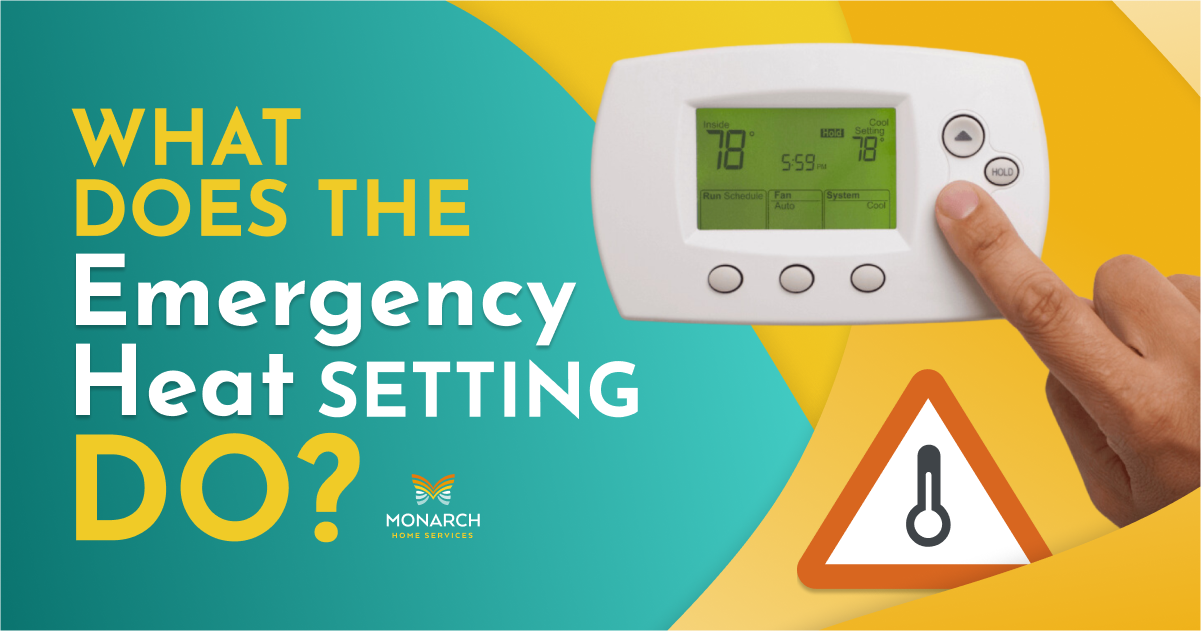
Do you have a heat pump? If so, you may have noticed it has an emergency heat setting. It’s one of those features, along with heating and cooling functions and compatibility with Wi-Fi thermostats, that make heat pumps so versatile.
Your home likely has a backup heater if your region sometimes gets colder than the primary unit can handle. When you turn on the emergency heat setting, the backup unit starts running. Meanwhile, the heat pump and compressor shut down to avoid damage.
How Does the Emergency Heat Setting Work?
A heat pump provides warmth by pulling heat in from outdoors. When operating in reverse, it can transfer and release heat outside to cool your home. Heat pumps are most effective in relatively mild areas. However, if it gets too cold outside and the unit can’t pull in enough warmth, a secondary emergency heat source can be used.
You may see an “em heat” setting on your thermostat. It can be activated manually to turn on an electric heat strip in the air handler or an oil or gas furnace. Most emergency heat systems are electric. You shouldn’t need emergency heat if the outside temperature is above 40℉. If so, call an HVAC contractor to check and, if necessary, repair the system.
Is Emergency Heat the Same as Auxiliary Heat?
There is also sometimes an “aux heat” function on the thermostat. Auxiliary heating is automatic. It turns on if the outdoor temperature briefly dips below a threshold and there’s a 2℉ to 3℉ difference between the setting and the actual indoor temperature. The system will run supplemental heating for several hours via an electric heat strip (which won’t work if your heat pump freezes).
When Should I Use Emergency Heat?
The emergency heat setting usually kicks in automatically when the outdoor temperature drops to between 30℉ and 35℉. However, you can turn it on manually, as we’ve mentioned, in cases such as:
- The outside temperature is so cold your home won’t warm up.
- Your heat pump shuts down in extreme cold or during an ice storm.
- A heavy branch or debris falls onto and damages your heat pump.
- You’re waiting for an HVAC professional to arrive and repair the unit.
- You’re waiting for the unit to thaw out.
When to Avoid Using Emergency Heat
You shouldn’t use emergency heat just because it’s cold. Most heat pumps can pull heat from outdoor air that feels chilly to you; the thermostat will automatically trigger emergency heat if necessary (turn on the setting only if your heat pump stops working). After it kicks in, it’s up to you to switch your heat pump back to normal operating mode. Operating the emergency heater for too long can strain it. This is especially a problem if the backup heater is in the heat pump itself (less so if the backup unit is a furnace).
Backup heating elements are designed to be used for a short time. Since they’re a second source of heating, running them uses more energy so you’ll end up paying more on your electric bill. Therefore, run emergency heat only until the temperature rises or the issue with your heat pump is resolved. Also, don’t try to fix the problem yourself; call an HVAC professional with experience servicing your type of unit.
Frequently Asked Questions
How Long Should I Run Emergency Heat?
There’s no specific timeframe for using the emergency heat setting. If you need it for a few hours, the system should be fine. Or, keep it on until the unit thaws out or is fixed.
How Cold Is Too Cold for a Heat Pump?
Most heat pumps stop running efficiently at temperatures between 25℉ and 40℉. While a heat pump typically won’t stop running as soon as it drops below 40℉, it will be less energy efficient the colder it gets. Many models can continue providing heat in temperatures as low as 5℉ or even below zero.
What Is the Optimal Heat Setting for My Heat Pump?
Regardless of the outdoor temperature, the best temperature to set your heat pump to in the winter is 68℉ to 70℉. This is when it runs most efficiently, whether operating at full capacity or using its backup heating element.
Is Your Heat Pump Not Working? Call Monarch Home Services
The emergency heat setting on your heat pump is a useful feature. But you shouldn’t use it too much. If your heat pump stops working or is less effective, contact us to inspect and repair it. Our licensed HVAC technicians are trained and equipped to repair any problem quickly. To schedule heat pump service in Central California or learn more about products like Wi-Fi thermostats that can save you energy and money, call (661) 215-6657 today.

